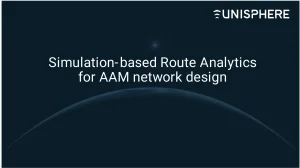- Directory
- Advanced Air Mobility White Papers
- Advanced Air Mobility (AAM)
- Simulation-based Route Analytics for AAM network design
Simulation-based Route Analytics for AAM network design
White Paper Details
This white paper analyzes weather impacts on eVTOL air taxi operations through flight simulations of routes in San Francisco Bay Area and Chicago. Using historic weather data from 2020-2024, it examines how wind affects flight times, energy consumption, and operational planning for different eVTOL configurations at various altitudes.
This white paper on Simulation-based Route Analytics for AAM network design presents a comprehensive analysis of wind effects on electric vertical takeoff and landing (eVTOL) aircraft operations. Published by Unisphere GmbH, the study examines specific air taxi routes in the San Francisco Bay Area (San Francisco South to Napa and Livermore) and Chicago (city to international airport) using four years of historic weather model data.
The research employs 4D flight simulations incorporating wind speed and direction data to assess their impact on three eVTOL configurations: multicopter (100 km/h cruise), lift-and-cruise (150 km/h), and tiltrotor (240 km/h). Key findings reveal that lower-speed eVTOLs experience flight time variations up to 40% due to wind, while faster configurations see only 10% variation. The study demonstrates significant seasonal impacts, with headwind conditions more prevalent during winter months, potentially extending flight times by up to 2.6 times for slower aircraft.
The white paper addresses critical operational considerations including charging cycle management, capacity planning, flight safety, and cost optimization. It emphasizes that eVTOL operators must implement aviation-grade planning to account for wind impacts, particularly given these aircraft's relatively low cruise speeds compared to traditional aviation.
=The analysis provides valuable insights for route design, showing how altitude selection and speed flexibility can mitigate wind effects.
The document concludes with recommendations for eVTOL design optimization, suggesting that configurations with higher cruise speeds and broad operational speed ranges offer advantages in wind-affected operations. It also highlights the importance of flexible airspace management and detailed performance modeling for successful Advanced Air Mobility implementation. This research provides essential data for operators, manufacturers, and regulators planning sustainable urban air mobility networks.
